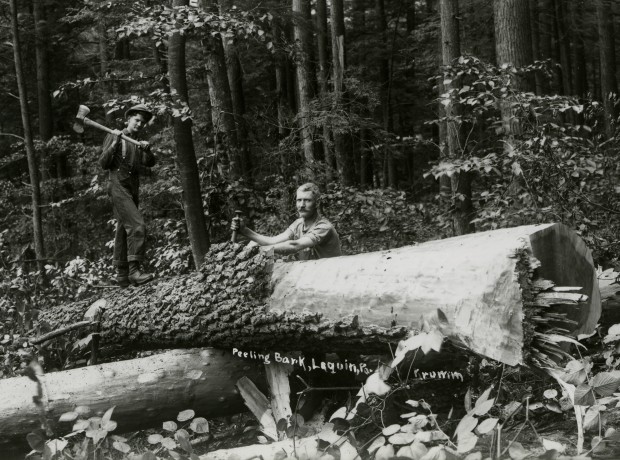Towanda’s First Two Booms
-
Scott Detrow

Towanda’s second boom: Jobbers cut hemlock trees and peel bark on nearby Barclay Mountain around 1910.
StateImpact Pennsylvania’s latest project, BoomTown, documents how natural gas drilling has affected Towanda, Bradford County. Click here to watch and listen to the report.
_____
An industry moves into the area, builds up the community’s population and infrastructure, and makes a lot of money for a lot of people as it extracts natural resources.
It’s happening now in Towanda, with natural gas drilled from the Marcellus Shale formation deep underground. But it’s a storyline that has repeated itself in the Bradford County community for 200 years.
Exactly 200 years, in fact – the area’s first big coal boom began in 1812.
“The lumber and coal industry is where a lot of the money that made Towanda came from,” says Matt Carl, who manages the Bradford County Historical Society. The organization is based in the former Bradford County jail. Carl keeps historic documents in old jail cells, and organizes lectures and parties in the courtyard where criminals used to be hanged.
The coal industry peaked in the 1880s and 1890s. Bradford County’s last operational mine closed in 1983.
The lumber boom started around 1890, but abruptly ended in the early 1930s. The reason: “They ran out of wood and stopped cutting,” Carl says.
That isn’t an exaggeration. The lumber industry clear-cut mountain after mountain in northeast Pennsylvania. The beautiful forest landscape that exists there today wouldn’t exist without the replanting efforts of the federal Civilian Conservation Corps during the New Deal.
The coal and lumber booms were more dramatic than the current one tied to natural gas drilling. That’s because the coal and lumber industries literally built towns from scratch, to house their employees.
Carl sees parallels between the old booms and the new one. “When I talk [to groups] about the history of coal, we talk about how the natural gas industry is bascially the same thing as those industries, just with more modern technology,” says Carl. “The only difference is back then, they built actual towns around the coal mining and lumber, whereas today they live all over the county and they travel to all these sites.”
The Historical Society’s museum devotes an entire floor to the coal and timber booms. Carl says they’re already thinking about how to document Towanda’s Marcellus Shale era. “People will be looking back and wondering what it was like during the natural gas industry. We’ve thought about what sort of artifacts would represent this era.”
Historians like Carl can’t help but worry about this third boom’s legacy. After all, both coal and lumber left devastating environmental damage. “We like to think technology is different, and we have different attitudes now about how people treat the land, but I guess it remains to be seen,” he says. “We certainly have thought about that a lot. After the coal industry, the land was left with acid mine runoff we still deal with today. And the lumbering, there were no trees left. Hopefully today it’s different.”
















